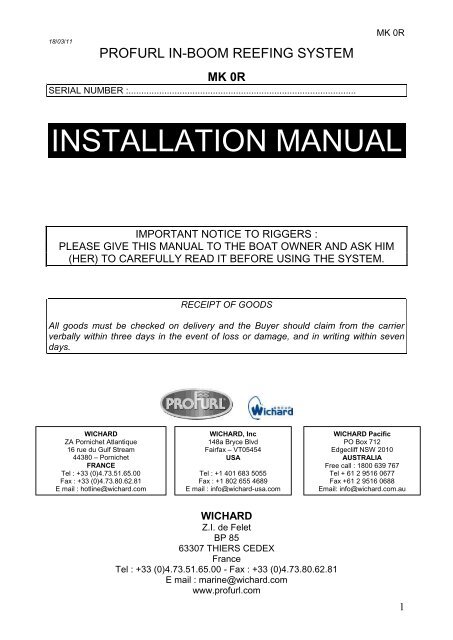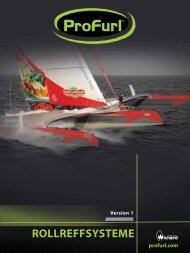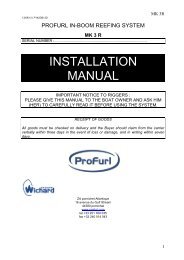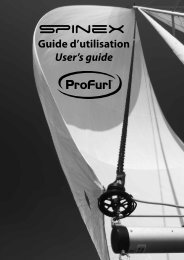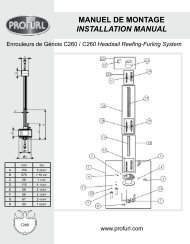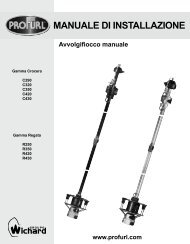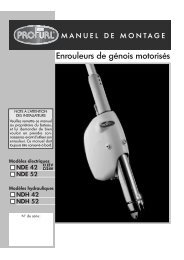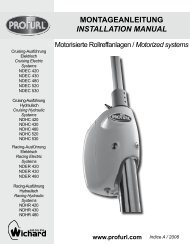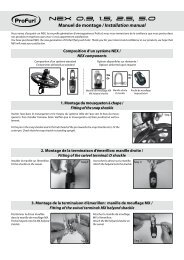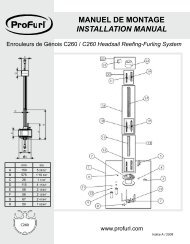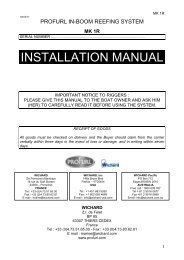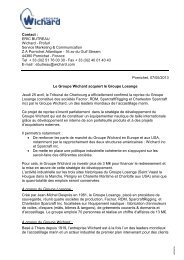PROFURL IN-BOOM REEFING SYSTEM
PROFURL IN-BOOM REEFING SYSTEM
PROFURL IN-BOOM REEFING SYSTEM
- No tags were found...
Create successful ePaper yourself
Turn your PDF publications into a flip-book with our unique Google optimized e-Paper software.
18/03/11<strong>PROFURL</strong> <strong>IN</strong>-<strong>BOOM</strong> REEF<strong>IN</strong>G <strong>SYSTEM</strong>MK 0RMK 0RSERIAL NUMBER :.........................................................................................<strong>IN</strong>STALLATION MANUALIMPORTANT NOTICE TO RIGGERS :PLEASE GIVE THIS MANUAL TO THE BOAT OWNER AND ASK HIM(HER) TO CAREFULLY READ IT BEFORE US<strong>IN</strong>G THE <strong>SYSTEM</strong>.RECEIPT OF GOODSAll goods must be checked on delivery and the Buyer should claim from the carrierverbally within three days in the event of loss or damage, and in writing within sevendays.WICHARDZA Pornichet Atlantique16 rue du Gulf Stream44380 – PornichetFRANCETel : +33 (0)4.73.51.65.00Fax : +33 (0)4.73.80.62.81E mail : hotline@wichard.comWICHARD, Inc148a Bryce BlvdFairfax – VT05454USATel : +1 401 683 5055Fax : +1 802 655 4689E mail : info@wichard-usa.comWICHARD PacificPO Box 712Edgecliff NSW 2010AUSTRALIAFree call : 1800 639 767Tel + 61 2 9516 0677Fax +61 2 9516 0688Email: info@wichard.com.auWICHARDZ.I. de FeletBP 8563307 THIERS CEDEXFranceTel : +33 (0)4.73.51.65.00 - Fax : +33 (0)4.73.80.62.81E mail : marine@wichard.comwww.profurl.com1
MK 0RCongratulations for the purchase of your <strong>PROFURL</strong> in-boom reefing furling system.Please read carefully this manual. It will give you to all information for fitting and usingyour system in order to give you many years of dependable service.! TheIMPORTANT WARN<strong>IN</strong>G FOR US<strong>IN</strong>GYOUR <strong>SYSTEM</strong> :<strong>PROFURL</strong> boom is obviously heavier than a conventional boom.Avoid uncontrolled gibing, specially with strong wind, as you couldpermanently damage your system.Reminder to gibe :1 - take in or winch your main traveller and main sheet2 - turn your boat to gibe3 - gradually release your main traveller and main sheet.You can even better fit a tackle as boom preventer (see drawing).You can also fit a boom brake, but you must not forget to completelyrelease it each time you want to operate your system.2
MK 0RCONTENTSI. PRELIM<strong>IN</strong>ARY ....................................................................................................................................... 4I.1 General description ......................................................................................................................... 4I.2 TOOLS NEEDED FOR FITT<strong>IN</strong>G .................................................................................................... 6II. PREPARATION .................................................................................................................................. 6II.1 Unfitting the hardware FROM the mast .......................................................................................... 6III. <strong>IN</strong>STALLATION .................................................................................................................................. 7III.1 DETERM<strong>IN</strong><strong>IN</strong>G THE HEIGHT OF THE GOOSENECK ................................................................ 7III.2 FITT<strong>IN</strong>G THE SLIDE SCREWS <strong>IN</strong>TO THE MAST TRACK ........................................................... 7III.3 FITT<strong>IN</strong>G THE GOOSENECK ......................................................................................................... 8III.4 FITT<strong>IN</strong>G THE HALYARD SPREADER ........................................................................................... 8III.5 ASSEMBL<strong>IN</strong>G THE LUFF SECTION & LUFF TRIANGLE & FEEDER .......................................... 9III.6 CUTT<strong>IN</strong>G THE <strong>BOOM</strong> SECTION AND THE MANDREL TO LENGTH ....................................... 14III.6.A How to calculate the length of the boom SECTION. ............................................................. 14III.6.B Cutting the mandrel (11F) to length ....................................................................................... 16III.6.C Fitting the mandrel onto the boom ......................................................................................... 16III.7 Fitting the boom onto the gooseneck............................................................................................ 17III.8 FITT<strong>IN</strong>G THE <strong>BOOM</strong>VANG HOUND AND THE <strong>BOOM</strong>VANG .................................................... 18III.9 FITT<strong>IN</strong>G OF THE LUFF TRIANGLE ON THE MAST ................................................................... 19III.10 ADJUST<strong>IN</strong>G THE POSITION OF THE MA<strong>IN</strong>SHEET BALES (1) ............................................ 19III.11 <strong>IN</strong>STALLATION OF THE CONTROL L<strong>IN</strong>ES TO THE COCKPIT ............................................. 20IV. FITT<strong>IN</strong>G THE MA<strong>IN</strong>SAIL ................................................................................................................. 21V. ADJUSTMENT OF THE <strong>BOOM</strong>VANG ANGLE TO THE MAST ...................................................... 23VI. US<strong>IN</strong>G THE <strong>PROFURL</strong> <strong>IN</strong>-<strong>BOOM</strong> REEF<strong>IN</strong>G <strong>SYSTEM</strong> .................................................................. 23VI.1 Rules of thumb : ............................................................................................................................ 23VI.2 LIMITS FOR US<strong>IN</strong>G THE <strong>SYSTEM</strong> <strong>IN</strong> RELATION WITH APPARENT W<strong>IN</strong>D ............................ 24VII. WARRANTY ..................................................................................................................................... 25VIII. MK0R SPARE PARTS LIST ............................................................................................................. 26IX. MA<strong>IN</strong>SAIL DESIGN SPECIFICATIONS ................................................. 28IX.1 GEOMETRY ................................................................................................................................. 28IX.1.A Luff curve design ................................................................................................................... 28Luff curve: ............................................................................................................................................ 28IX.1.B Foot curve design. ................................................................................................................. 28IX.1.C Roach .................................................................................................................................... 28IX.2 F<strong>IN</strong>ISH DESIGN ........................................................................................................................... 28IX.2.A Luff tape material ................................................................................................................... 28IX.2.B Foot tape diameter ................................................................................................................ 29IX.2.C Luff and foot TAPE diameter ................................................................................................. 29IX.2.D battens ................................................................................................................................... 29IX.2.E Clew tack and head assembly ............................................................................................... 29PRELIM<strong>IN</strong>ARY CAUTIONSThe <strong>PROFURL</strong> in-boom mainsail reefing system is not designed to beinstalled on wooden masts, or aluminium masts with track added withscrews, rivets, glue or any similar assembly. Fitting on a carbon mast is notrecommended as it requires specialized knowledge and skills. Pleasecontact us.Please check that there is no sign of corrosion on the mast which maycompromise the strength of the assembly.The person in charge with fitting will be fully responsible for installation andadaptation on board according to the specifications shown in this manual.3
I. PRELIM<strong>IN</strong>ARYMK 0RI.1 General descriptionNote : names in bold refer to parts shown on the exploded view page 5The <strong>PROFURL</strong> MK0 / R in-boom furling system includes :1. One set of plastic luff sections (16), each being 3 meter long, a sailcloth luff triangle (15),and a feeder (10). (15) and (10) are linked to the mast with conventional mast slugs (notprovided).One of the luff section (1) and the lower end of the luff triangle (2) will be re-cut to length tomatch the expected luff length of the mainsail.2. Joiners (9) are used to connect the various luff sections (16). They are locked by mean ofscrews- washers and nuts (9B).3. The bottom end of the luff sections (16) are screwed (10D) to the feeder (10). The lufftriangle (15) is linked to the foil sections by a luff rope.4. The luff triangle (15), the mast slugs strap (10F) and the feeder (10) are assembled bythreading (10C) of the two half feeder. The strap (10F) immobilization during assembly ismade with adhesive (10G).5. The assembly luff section + luff triangle + feeder is pulled up on masthead with thetopping lift or a lashing. The stretch strap (17) passing by the mainsheet bails (1) keep theluff section tight.6. A gooseneck (8) fit on the mast with 2 slide screws (5), and two gooseneck plates (13)bent to the mast‟s shape while fitting, and then riveted onto the mast with the pop rivets (14)supplied.7. A boom section (11G) standard length 3.20 meter (10‟ 6”). It may be necessary to re-cutthe boom profile to length.8. A mandrel (11F) turns on bearings (11D) rotating around a bearing holder (11J) at therear end of the boom, and on the drum-bearing holder (11H) at the front, turning around apin (11E) inserted in each of the boom end fittings (11B and 11C). When re-cutting theboom profile (11G) to length, the mandrel (11F) should also be re-cut by the same amount.9. A drum boom end fitting (11B) includes the drum-bearing holder (11H) fitted into themandrel (11F) :when the drumis loaded with the furling line, pulling on the furling line whilereleasing the mainsail halyard will rotate the mandrel (11F), which will furl the sail.10. 3 adjustable mainsheet bails (1) : 2 to fix main sheet blocks, or a boom brake or a boompreventer, and 1 to fix the stretch trap (17).11. A special boom strut (6). It is attached :- to the mast by means of a boom strut attachment (7), including a gooseneck (7A)attached to the mast with 2 slide screws (5) and two gooseneck plates (12) which willbe bent and riveted to the mast with the pop rivets (14) supplied. The boom strutupper end will be attached onto an articulation fitting (7B) rotating in the boom vanggooseneck.- to the boom with an adjustable boom vang hound (2).4
MK 0R5122B2A4311I11K11D11A11J11L11C11G11F311H11D11L11K11I11E11A11E11B1166A6B5127B77A1615181710A10E10F10C10B10D10D10G1099A9B8B8C8D8Schéma d’ensemble et repères11A11B20
I.2 TOOLS NEEDED FOR FITT<strong>IN</strong>GMK 0RIn all cases of fitting• A tape line• An electric drill• A set of drills• A hack saw with a (new) blade with small teeth• A file• A pencil• A plastic hammer• Metrics 6 mm, 10 mm, 17 mm pipe-wrench.• A dynamometrical wrench (1daN/m)• 1 set of Allen wrenches (supplied)• 2 clamps with a minimum opening 250 mm (9 27/32‟‟)• Universal pliers• A cutter blade (with new blades)• A large sheet of paper with corners perfectly at 90° and adhesive tape• Several small plywood or rubber shims.• A pop rivet gun for Ø5 mm rivets.• A cross recess screwdriver• A hollow punch (supplied)• 2 standard mast slug 32 (1 17/64‟‟) long max (non supplied) fitted to the mast.Note : the plates to fit the gooseneck and boom vang attachments are 4 mm thick and made out ofaluminium. A convenient set of clamps with minimum 150 mm (6”) opening should be used to bend themat the mast shapeIf the fitting is made on a standing mast• A Boson‟s chair (while assembling the halyard spreader (20)).• Some short ropes of 6 or 8 mm (1/4” or 5/16”) diameterPlease purchase a 6 mm furling line and a ball bearing block to lead the furling line to the cockpit.II. PREPARATIONII.1 Unfitting the hardware FROM the mastII.1.A - Dismantle the original gooseneck, as well as cleats, winches and winchesbrackets on the mast, as well as any piece of equipment which would interfere with thefitting of the new gooseneck and with the ability for the forward boom end fitting torotate when the boom will swing from one side to the other.Please see § III.1. and drawing 1 for dimensions of the new gooseneck in relation with mark « C »on the mast.II.1.B - The original boom vang attachment should not be used, as the rotationaxis of the boom and of the new gooseneck need to be in line, which would never bethe case with the original boom vang attachment.II.1.C - Dismantle the original feeder (if any) at the mast track entrance.II.1.D - Check that the slide screws (5) supplied have suitable dimensions for themast track. If not, their width should be modified (turned, machined, grinned, filed)accordingly.In all other cases please contact us.6
MK 0RIII. <strong>IN</strong>STALLATIONIII.1 DETERM<strong>IN</strong><strong>IN</strong>G THE HEIGHT OF THE GOOSENECKIII.1.A -To avoid any potential conflict between the boom and the cabin top, abimini, a lifeline or any other piece of equipment, please accurately mark the level of thelower edge of the original boom. See drawing 1. and draw the line “C” on the mast.III.1.B - Check that the boom vang (6) delivered with your system will make onceinstalled a minimum 30° angle with the mast and the boom. Should it not be the case,the position of the new gooseneck (8) must be raised on the mast in order to obtain atleast this 30°angle .Note pin to pin boom vang length : 1100 mm (5’ 8 7/8”) open / 1005 mm (5’ 3 3/16”) closedIII.1.C - Draw a line « B »on the mast at 267mm (10’ 2 33/64”) above line« C ».The line « B » will correspond to the level of the upper edge of the gooseneckplates (12) once fit on the mast.Drawing 1III.2 FITT<strong>IN</strong>G THE SLIDE SCREWS <strong>IN</strong>TO THE MAST TRACKIII.2.A - 2 slide screws (5) are needed for the boomvang attachment (7)(SeeDrawing 7). Slide these slide screws (5) down to the mast foot to later fit the boom vangattachment (7) (See §III.8 p 18 ).III.2.B - Slide 2 extra slide screws (5) into the mast track for fitting thegooseneck(8).7
MK 0RIII.3 FITT<strong>IN</strong>G THE GOOSENECKIII.3.A - Attach the gooseneck (8) at the convenient height (§ III 1) with the 2corresponding slide screws (see § III.2.B), washers and locknuts (5). Tightening torquemust be 1 daN/m.III.3.B - Bend the aluminium gooseneck side plates (12) with clamps to accuratelycamber them to the mast shape. During bending please protect the plates from dingsand dents.III.3.C - Draw lead lines for drilling (Ø 5mm 13/64” drill) on the side plates (12)(suggested jig drill on annexe 1). Press the side plates on the mast with clamps ( pleaseprotect the plates with any convenient means). There should have at least 6 pop rivets(13) on the mast on each side plate (12).III.4 FITT<strong>IN</strong>G THE HALYARD SPREADERThe halyard spreader (20) is necessary if the sheave from the mast crane don‟tcarried out enough (50mm 1 31/32‟‟ minimally) the halyard from the mast bottom part.ADVIS<strong>IN</strong>G :we recommend to contact a rigger or to use a specific climbing equipment.III.4.A – Position the halyard spreader on themast (the highest possible).III.4.B – Point the mast according the drill onthe halyard spreader and bore at Ø5mm(13/64”).III.4.C – Hang the halyard spreader to the mastwith pop rivet (supplied).8
MK 0RIII.5 ASSEMBL<strong>IN</strong>G THE LUFF SECTION & LUFF TRIANGLE & FEEDERIII.5.A – Pull up the main sail halyard to the masthead and measure withtape line lenght “X” to the “C” drawing previously marked.Deduct 520mm (1‟8 15/32‟‟) from this value :Y = X – 520mm Y = X – 1’ 8 15/32’’Caution : Ensure that “Y” measure do not occur with the mast lufftrack entrance. If it is the case, you would increase or decreasethe “Y“ value of 100mm (3 15/16‟‟).III.5.B – Cut carefully with cutter blade the lower part from the luff triangle(15) to the “Y” value from the upper part (Picture A). Cut up the luff line 50mm (1 31/32‟‟)shorter than the cut (Picture B and C).Photo A Photo B PhotoCIII.5.C – Thread the luff section (16) on to the luff tape of the luff triangle (15)(Picture D) and assemble them with the connector (9) (Picture E). Fit the connector‟sscrew (9B) (Picture G) after coating the end part of the threading with Profurl adhesive52052 (Picture F).Photo DPhoto E9
MK 0RPhoto FPhoto GIII.5.D – Position then this foil section so as it rise to the surface to theextremity part of the luff line in the lower part of the luff triangle (15) (Picture H). Cutsurplus foil section (16) exceeding on upper part : it end would have to respectivelyraise the high end of the luff triangle (Picture I). Burr the cut (Picture J).Photo H Photo I Photo JIII.5.E – Feeder fitting : Most of the time the front part of the feeder (10) willhave to be recur (Picture K). The feeder will have to be shortened so as been the lufftriangle (15). The cut will be done according the appropriate groove (closest uppergroove) so as to the drawing 2 arrangement.Drawing 210
MK 0RPosition temporarily the 2 half-feeder (10A and 10B) to identify the cuttinggroove (Picture L). Cut and burr.Photo KPhoto LIII.5.F – Arrange the double coated tape adhesive (10G) onto the 2 halffeeder nick design for (Picture M). Shorten it if necessary (Picture N).Photo MPhoto NIII.5.G – Arrange the two half feeder (10A and 10B) in opposite (Picture O).Get pass the mast slugs strap (10F) onto mast slugs (not provided) (Picture P).Photo OPhoto PPut the strap flatly onto the two half feeder neck designed. Cut off the extralength of the strap (Picture Q) if necessary so as, while the feeder is closed, to keep themast slugs at 5mm (13/64‟‟) from the feeder mast part extremity (Picture R). Take out theprotection from the double coated tape adhesive and stick definitively the strap on.11
MK 0RPhoto QPhoto RIII.5.H – Close the two half feeder (10A and 10B) to shut away the lower partof luff triangle (15) and the foil section (16) into the corresponding shape (Picture T).The two lower parts, from the luff triangle and from the feeder will have to coincide(Picture S). If a grommet from the luff triangle hemp the feeder closing, just suppress ittidily.Photo SPhoto TIII.5.I – Fit the two half feeder (10A and 10B) with the self-tapping screwprovided (10C) (Picture U). Do not force the binding!III.5.J – Position and crimp the thimble (10E) with the hollow punch(provided) (Picture V).Photo UPhoto V12
MK 0RIII.5.K – Drill the lower part, Ø4 mm (5/32‟‟) hole of the foil section (16)according to the feeder shaped hole. Fit by screw and nut (10D) the feeder (10) and thefoil section (16) (Picture X).Photo WPhoto XIII.5.L – Mast slide: Take out the mast slide from the original main sail.Caution: Keep this mast slide as it will be fitted on the front part of the luff section (15)thanks to the snap-in shackles provided (Picture Y). (See mainsail design specificationIX.2.D)Photo Y13
MK 0RIII.6 CUTT<strong>IN</strong>G THE <strong>BOOM</strong> SECTION AND THE MANDREL TO LENGTHIII.6.ACase # 1:Case # 2:How to calculate the length of the boom SECTION.<strong>PROFURL</strong> took care of cutting the boom for you to your specific lengthThe <strong>PROFURL</strong> boom being delivered in over length (standard length), theopportunity may be taken to make the boom longer. Caution : changingthe boom length and foot length of the sail will affect the balance at thehelm when sailing under sails. In this case check that the aft end of theboom cannot touch the backstay or any other piece of equipment onboard.Drawing 3 refer to case #1 for dimensions.Drawing 3The <strong>PROFURL</strong> in-boom reefing system is delivered pre-assembled. In case #2the boom section (11G) and the mandrel (11F) may have to be re-cut to length to matchthe boat‟s requirements when fitting the system.CAUTION : should the complete length of the boom profile be used, the rearboom end fitting is just temporarily attached to the boom profile forshipping. Please follow the rear end boom fitting assembly procedure from §III.6.C.5 and on as if the boom profile had been re-cut.14
MK 0RIII.6.A.1 - To cut the boom section (11G) and the mandrel (11F) to length, firstdismantle the rear boom end fitting (11C) from the boom section and pull out themandrel (11F) from the boom section.Caution : during dismantling, the mandrel (11F) will not be held any more. Pleasecontrol the mandrel as it potentially may fall down, when pulled backwards. Also takecare not to lose the washers (11I & 11K) located forward of the drum (11H).III.6.A.2 - To re-cut the boom section (11G) to length, and to make sure that thecut is accurately perpendicular to the section, wrap a sheet of paper or Mylar (withaccurate right angle corners) so that the edges are in perfect line, and attach it withadhesive tape. Please see drawing 4. Draw a line on the boom profile, following theedge of the sheet where the boom profile will be cut.III.6.A.3 - Cut the boom profile according to the line and file smooth.Drawing 415
III.6.BCutting the mandrel (11F) to lengthMK 0RThe mandrel (11F) should be re-cut of exactly the same length of the one havingbeen cut off from the boom section.III.6.B.1 – Remove the bearing holder (11J) + bearing (11D) assembly from therear end of the mandrel (11F).III.6.B.2 - Cut the mandrel (11F) at its rear end with the same method as the onehaving been used for cutting the boom section (11G). Same as § III.6.A.2, File the rear(cut) end of the mandrel and foot track ends smooth.Caution : the forward (drum) end of the mandrel (11F) must not be cut !III.6.B.3 - Fit again the bearing (11D) and bearing holder (11J) into the cut/rearend of the mandrel. Drill at 7mm and tap at M8 (8mm) at 30 mm (1 3/16‟‟) from the cutend. Fit and tighten the set screw (11A).III.6.B.4 - In case the mandrel has been cut a little too short, the fore and aft playmust be reduced to a minimum. To do this, loosen screw (11A), push the mandrelforward, and then pull out the bearing holder (11J) so that the washer (11I) touchesbackwards, tighten again screw (11A).III.6.CFitting the mandrel onto the boomIII.6.C.1 - Fit the mandrel (11F) into the boom section (11G), fit the washers (11Iand 11K), the drum (11H) and the drum bearing (11D) onto the stainless steel pin (11E)inserted in the drum boom end fitting (11B).III.6.C.2 - Check that the mainsheet bales (1) and boom vang hound (2) areproperly fitted in the bottom track of the boom section as shown on drawing 6.III.6.C.3 - Slide the bearing (11D and 11J) and the washers (11I and 11K) locatedat the rear end of the mandrel (11F) onto the stainless steel pin inserted in the rearboom end fitting (11C).III.6.C.4 - Completely insert the rear boom end fitting over the rear (cut) end of theboom profile (11G). A ratchet tie down strap is a handy and powerful tool to achieve this if necessary.III.6.C.5 - Drill holes 5mm (13/64‟‟)at the rear end of the boom profile (11G)through the pre-drilled holes of the rear boom end fitting (11C). Fit the correspondingpop rivets (11L) supplied into these holes to permanently attach the boom end fittingonto the boom profile.Drawing 516
III.7 Fitting the boom onto the gooseneckMK 0RIII.7.A - Hoist the boom with a halyard and a topping lift (see drawing 6) bykeeping it as horizontal as possible.III.7.B – Fit horizontal pin (8D) . Fit and open split pin (8A).Caution : do not drop or raise the boom more than 15° from horizontal position asit could cause permanent damage to the gooseneck (8).Drawing 617
MK 0RIII.8 FITT<strong>IN</strong>G THE <strong>BOOM</strong>VANG HOUND AND THE <strong>BOOM</strong>VANGReminder: the ideal working angle of the boomvang being 45° the boomvang must notangle less than 30 ° with the mast or boom.III.8.A - Fit the boom vang attachment (7) with the 2 slide screws (5) which hadbeen stored at the mast foot (please see § III.2.B).III.8.B - Bend the aluminium gooseneck side plates (12) to the mast shape.During bending please protect the plates from dings and dents.III.8.C - Draw lead lines for drilling on the side plates (12) (suggested jig drill onannexe 1). Drill at Ø 5 mm (13/64‟‟) and fit the pop rivets (13) on the side plates. Thereshould have at least 6 pop rivets (13) on the mast on each side plate.III.8.D - Fit the boom vang (6) onto the articulation eye (7B) and onto the boomvang hound (2). Fit the pins (6A and 6B) and the split pins.Drawing 718
III.9 FITT<strong>IN</strong>G OF THE LUFF TRIANGLE ON THE MASTMK 0RIII.9.A – Insert the mast slug into the mast luff track and pull up the lufftriangle to masthead.During this step avoid excessive bending from the foil section. Side mastapproach is advised.III.9.B – Pass the strecht strap (17) into the feeder‟s thimble (10E) and intothe mainsheet bales on mast side. Close and stretch moderately the stretch strapbuckle. (Picture Z1 and Z2).Photo Z1Photo Z2III.9.C – Move backwards the mainsheet bales (1) to hardly stretch the strap(17) and immobilize it with its two set screws (1B).III.10 ADJUST<strong>IN</strong>G THE POSITION OF THE MA<strong>IN</strong>SHEET BALES (1)III.10.A - Adjust the position of the mainsheet bales (1) with the set screws whichcan be reached from underneath the boom section. Fasten the mainsheet blocks on themainsheet bales.CAUTION: on boats with a mainsail track or mainsail block attachment on deck aheadof the main hatch the mainsheet bales (1) must be re-positioned as far backward aspossible.III.10.B - Push the boom by hand over the lifelines as far as possible and tie aknot on the mainsheet so that in no case the boom section can be damaged by therearmost shrouds when running downwind or jibing.19
III.11 <strong>IN</strong>STALLATION OF THE CONTROL L<strong>IN</strong>ES TO THE COCKPITMK 0RREM<strong>IN</strong>DER TO AVOID FRICTION1. Only use good quality ball bearing blocks, which will have to be cleaned andlubricated from time to time as per manufacturer‟s specifications.2. Use ball bearing blocks with a sheave of large diameter.3. Reduce as much as possible the number of lead blocks between the drum and thecockpit.4. Reduce as much as possible the angle of deviation of the control lines.III.11.A- Attach on starboard a ball bearing block (not supplied) to the mastfoot at the convenient position to lead the line into the middle of the drum at 90° angle.III.11.B - Pass the furling line from underneath through the block, thenthrough the hole of the drum‟s shaft and a tie small knot at its end so that the knot willbe completely hidden inside the drum‟s shaft. Please see drawing 8.Drawing 8III.11.C - To fill the drum with line turn the mandrel (11F) by hand anticlockwise (seen from above): the furling line should exit from the drum on the starboardside.III.11.D - Fit another ball bearing block at the mast foot to lead the mainsailhalyard to the cockpit. Remind to use the right type and dimensions of blocks.III.11.E - Check that the exit from the mast of the mainsail halyard does notbring too much chafe. If necessary change for a new less aggressive halyard exit, orchange position of the mast foot block to keep the halyard on line with the exit.20
MK 0RIV. FITT<strong>IN</strong>G THE MA<strong>IN</strong>SAILPlease check again that the foot track rear end has been smooth filed beforestarting inserting the foot tape into the mandrel’s foot track.CAUTION : before operating the <strong>PROFURL</strong> in-boom reefing system please makesure that :1) the mainsail construction and design are in accordance with the attachedspecifications. Please refer to attached mainsail design specifications.2) the boomvang (6) angle adjustment ( see § V ) is correct. This adjustment is anessential point to get a good quality furling of the mainsail as well as ease ofoperation.IV.1 - Turn the mandrel (11F) by hand so that the track of mandrel isupwards.IV.2 - Do not yet insert the mainsail battens into the batten pockets.IV.3 - Insert the tack slide (3) into the tack webbing of the sail. Please seedrawing 9.Drawing 9IV.4 - Insert together both webbing and tack slide (3) into the port side foottrack. Insert the bolt rope foot tape into the mandrel (11F) track and gently pull thesail forward.IV.5 - Once almost at the end insert the second clew slide (3) into the clewwebbing so that the webbing is locked between the two small plastic cylinders of theclew slide (3), and insert the clew slide into the track of the mandrel (16). Please seedrawing 10.IV.6 – Push the tack slide (3) to the front.21
MK 0RDrawing 10IV.7 – Tie a knot on the lashing line (4 mm diameter supplied) and insert theknots in the slot of the mandrel (11F) so as to include the clew webbing and thebuckle created. (Picture AA) The length between the two knot of the reef point so asthe mainsail luff line set out with the feeder entry (10).Picture AAIV.8 - Lash the Ø4 (5/32‟‟) line between the clew webbing and the ring of theclew pin (4) and adjust foot tension. Check to tie or cut any loose extra length oflashing line.IV.9 - Insert the battens into the batten pockets.IV.10 - Attach the halyard onto the head of the mainsail.IV.11 – Insert the mainsail luff line into the feeder and pull it up.22
MK 0RV. ADJUSTMENT OF THE <strong>BOOM</strong>VANG ANGLE TO THEMASTThis essential procedure must be achieved either with no wind at all,or with extremely calm wind and the boat heading into the wind.V.1 - Hoist the sail as previously described and tension your halyard quitehard.V.2 - Completely loosen the nuts of the boom vang hound (2A), and makesure the hound (2) is totally free to move fore and aft in the lower track of the boom.V.3 - Make sure the mainsheet is completely loose and let the boom hang inthis position, just held by the mainsail.V.4 - Tighten again the nuts of the boom vang hound (2A) with the boom inthis position.V.5 -The sail can now be furled by gently releasing the halyard and pullingtogether on the furling line.V.6 - Fine tuning of the boomvang position adjustment may benecessary :1. If the luff tape rolls too much backwards, adjust the boom vang hound (2)position so that the boom angles up a little more.2. If the luff tape rolls too much forward, adjust the boom vang hound (2)position so that the boom angles down a little more.VI. US<strong>IN</strong>G THE <strong>PROFURL</strong> <strong>IN</strong>-<strong>BOOM</strong> REEF<strong>IN</strong>G <strong>SYSTEM</strong>IMPORTANT WARN<strong>IN</strong>G: when gibing please keep constant control of theboom with the mainsheet.You can also install a boom brake. If a boom brake is added release iteach time before operating the system.VI.1 Rules of thumb :1. Make the boat„s angle with the wind corresponding to a broadreaching or closer to the wind.2. Before using the system completely release the mainsheet so thatthe boom vang push effect brings back the angle between theboom and the mast to its « operating » position.3. If the mainsail is not properly do not attempt to correct thisimmediately, but hoist the sail completely, check points as per§V.6 and try again.After a short period of time you will feel how much drag is to be given tothe halyard to get the right tension to obtain a smooth furling of the sail.During hoisting the sail a slight drag should be applied to the furling line inorder to allow the furling line to be rolled tight enough in the drum: this will makenext furling easier.23
MK 0RShould you wish to just a reef your sail, please carefully check that thehead of the sail is just above a connector/articulation in order to prevent the luffprofile to sag too much. Please stick insignia reefing marks on the luff of the sailwhich will be at feeder level to show when the head is at the convenient position.When in harbour, or sailing under power, please remove thehalyard from the head of the mainsail, attach it onto the rear end ofthe boom and tension it.VI.2 LIMITS FOR US<strong>IN</strong>G THE <strong>SYSTEM</strong> <strong>IN</strong> RELATION WITH APPARENTW<strong>IN</strong>DSome boats have spreaders at 90° from boat‟s axis, some other have spreadersangling backwards. Some other have aft shrouds.In these last cases the sail will drag on the standing rigging earlier than withboats having spreaders at 90°. This means that the sailcloth will touch thestanding rigging sooner or later depending on each boat. A smooth operation isobtained as long as the sail is not touching any shroud or spreader when themainsheet is completely released. In other terms it is necessary to come into thewind to reef or furl the sail just as you would have done with conventionalmainsail reefing.However in case of emergency the sail can be rolled at larger angles to the windtill the stage when the friction on the standing rigging will make the system moreand more difficult to operate. Friction would also obviously increase with thewind‟s speed. In this case a smooth furling can‟t be guaranteed24
MK 0RVII. WARRANTY1- The <strong>PROFURL</strong> in-boom reefing system is warranted for 3 years from date of purchase againstparts and materials, provided the warranty card is returned within fifteen days from date of purchase. Thewarranty covers the original owner and is not transferable.2 -The warranty is limited to the repair and replacement of defective parts only by an authorised<strong>PROFURL</strong> dealer and only after the written consent of <strong>PROFURL</strong> France or <strong>PROFURL</strong> USA .3 - This warranty covers only the <strong>PROFURL</strong> parts and materials. Any accidental damages orexpenses are not covered.4 - This warranty is void if the system is modified or repaired without prior written notification to<strong>PROFURL</strong> France/USA.5 - This warranty does not cover damages caused by systems which has not been properlyinstalled.6 - This warranty does not cover the misfunctionning of the system due to a sail having beenmade without strictly following the attached specifications.7 - After installation the customer should check the following :- the sail dimensions are accurately adapted to the system‟s dimensions.- the sail has been designed and made according to the attached specifications.- all screws are properly tightened.- the fitting and adjustment procedures described in this manual are strictly followed.----------------------------------------------------------------------------------------------------------------------------------------------Please return this portion within 15 days of purchase to :WICHARDZA Pornichet Atlantique16 rue du Gulf Stream44380 – PornichetFRANCETel : +33 (0)4.73.51.65.00Fax : +33 (0)4.73.80.62.81E mail : hotline@wichard.comWICHARD, Inc148a Bryce BlvdFairfax – VT05454USATel : +1 401 683 5055Fax : +1 802 655 4689E mail : info@wichard-usa.comWICHARD PacificPO Box 712Edgecliff NSW 2010AUSTRALIAFree call : 1800 639 767Tel + 61 2 9516 0677Fax +61 2 9516 0688Email: info@wichard.com.auOwner‟s name :.............................................................Date of purchase :.............................................................Boat‟s type.............................................................Boat‟s length.......................................................Boat‟s displacement..................................................Mainsail‟s luff length................................Mainsail‟s foot length.................................Installed by.......................................................Date………………………………………………………………..Owner‟s signature :25
VIII. MK0R SPARE PARTS LISTMK 0RRef SousEnsembleRefpiècesDésignationRepèreRef SousEnsembleRef pièces Désignation Repère51068 GOOSENECK SIDEPLATES 1251203 POP RIVET MAGNALOK MGLP B6 7 ALU 13P280021 COMPLETE GOOSENECK ARTICULATION 851203C POP RIVET MAGNALOK MGLP B6 4 ALU 14 01224 LOCKNUT M1052199 LUFF TRIANGLE 12600 MM 15 02310 SPLIT P<strong>IN</strong> V 3,2x20 8A52196 LUFF SECTION 3M LONG 1652198 STRETCH STRAP 1752208 SNAP-<strong>IN</strong> SHACKLE 1852211 LASH<strong>IN</strong>G L<strong>IN</strong>E (Ø4mm) 1952212 HALYARD SPREADER 2002885 LOCKNUT HM M1002886 WASHER M10 TYPE Z- STA<strong>IN</strong>LESS STEEL51022 GOOSENECK ONLY 8B51036 VERTICAL GOOSENECK P<strong>IN</strong> 8C51038 HORIZONTAL GOOSENECK P<strong>IN</strong> 8D51052 GOOSENECK TOGGLEP177024 MA<strong>IN</strong>SHEET BALE 1 51063 WASHER PA6 24/14,2 EP=501659 MA<strong>IN</strong>SHEET BALE R<strong>IN</strong>G 1A 51109 WASHER NYLON 15,2x26x1,402346 SET SCREW STHc M8x8 1B 51182 LOCKNUT CAP KAPSTO51244 GOOSENECK SHEATHP177130 COMPLETE <strong>BOOM</strong>VANG HOUND 200018 LOCKNUT M8 2A50444 <strong>BOOM</strong>VANG HOUND 2B50657 WASHER LN 8P191017 CLEW SLIDE 3P280050 LUFF SECTION CONNECTOR 952197 LUFF SECTION JO<strong>IN</strong>ER 9A52201 SCREW M3x16 POZZI D<strong>IN</strong> 965 9B52202 NUT HU M3 D<strong>IN</strong> 934 9B52203 WASHER M3,2 D<strong>IN</strong> 125 9BP191019 CLEW P<strong>IN</strong> 4P191039 SLIDE SCREWS 5P191100 COMPLETE <strong>BOOM</strong>VANG 651062 HIGH P<strong>IN</strong> 6A51064 LOW P<strong>IN</strong> 6B51097 SPLIT P<strong>IN</strong> d2,5x20P191210 COMPLETE <strong>BOOM</strong>VANG ATTACHEMENT 7P280060 FEEDER 1052185 PORTSIDE HALF FEEDER 10A52186 STARBORD HALF FEEDER 10B52204 SELF TAPP<strong>IN</strong>G SCREW M10*13 D<strong>IN</strong> 7981POZI 10C52205 SCREW TRHC M4x20 A2 10D52206 NUT HmM4 D<strong>IN</strong> 439B 10D52207 THIMBLE 10E52209 POLYESTER STRAP 20x270 10F52210 DOUBLE COATED TAPE ADHESIVE 20x130 10G01224 LOCKNUT M10 P280010 MKOR-COMPLETE <strong>BOOM</strong> 1102885 LOCKNUT HM M10 02346 ST SCREW STHC M8x8 11A02886 WASHER M10 TYPE Z- STA<strong>IN</strong>LESS STEEL 51020 DRUM <strong>BOOM</strong> END FITT<strong>IN</strong>G 11B51022 GOOSENECK ONLY 7A 51021 REAR <strong>BOOM</strong> END FITT<strong>IN</strong>G 11C51057 ARTICULATION FORK 7B 51035 REAR BUSH<strong>IN</strong>G 11D51109 WASHER NYLON 15,2x26x1,4 51049 <strong>BOOM</strong> END P<strong>IN</strong> 11E51182 LOCKNUT CAP KAPSTO 52194 MANDREL 11F51244 GOOSENECK SHEATH 51089 <strong>BOOM</strong> PROFILE 11G52200 DRUM ONLY MK0R 11H51109 WASHER NYLON 15,2x26x1,4 11I51137 BEAR<strong>IN</strong>G HOLDER 11J51142 WASHER 14 TYPE M STA<strong>IN</strong>LESS STEEL 11K51203 POP RIVET MAGNALOK MGLP B6 7 ALU 11L26
MK 0R27MK0R <strong>BOOM</strong>P1770240165902346P177130504440001850657P191019P19101751109 5114251035023465113751203510215108952194P191017522005103551203511425110951049023465104951020P280010P1911005106251064P1910395106851057P1912105118201224028852886511095124451022521965219952208521985218552207522095220452186522065220552210P28006052197522015220252203510225103651052 51038P28002151182012240288502886510635124451109P2800505106452212
MK 0RIX. MA<strong>IN</strong>SAIL DESIGN SPECIFICATIONSIX.1 GEOMETRYIX.1.ALuff curve designThe luff curve design is one of the most essential points in the design of themainsail as it will determine how the sail will roll back and forth on the furlingmandrel to avoid overlapping of the luff tape, avoiding also the rear end of the boomto go down when the sail is being rolled.Starting with the mainsail fully hoisted :Stage 1 : when beginning to roll the luff tape has to move backwards up to thestage where a small crease appears between the feeder and the clew.Stage 2 : the luff tape has to move to forward till the stage where the luff tapegets close to the forward end of move backwards till the sail is completely furled.Luff curve:In reference with a straight line between the tack and the head, if theangle due to the luff curve is backwards the luff of the sail will roll backwards.Luff curve has to be “S” shaped from tack to head: negative in the lower partof the luff, positive in the upper part.Maximum value of the curve (from straight line between head and tack) in % :0.2% of luff length. If the mast has a camber just follow the samecorrection to luff curve as you would do with a conventional sail.Point of maximum negative curve at 20% of luff length measured from thetack.Point of maximum positive curve at 60% of luff length measured from the tack.IX.1.BFoot curve design.Value : maximum 1% of foot length at 50% of foot length.IX.1.CRoachValue: maximum 6% of leech lenght measured at 50% of leech length.Angle between luff and foot (luff and foot being a straight line) : 88°IX.2 F<strong>IN</strong>ISH DESIGNIX.2.ALuff tape materialLuff tape material must be made with a plastic PVC material with 5,5mm diameter,and sailcloth tape with Teflon, to obtain a Ø6mm finished luff tape diameter.28
MK 0RIX.2.BFoot tape diameterFinished 6mmIX.2.CLuff and foot TAPE diameterAs with any reefing sail, the fullness of the mainsail is to be somewhat flatter thanwith a conventional sail.On the leech broad seams are as usual.On the luff broad seams are to be design to obtain the suitable sail profile inrelation with the luff curve as described above.IX.2.Dbattens4 battens are to be usedMainsail will be semi-fully battened (please see drawing)Batten pockets must be sewn on the port side of the sail.Batten pockets nose should not go further than 6mm (15/64‟‟) from the front edgeof the luff tape to allow for the luff tape to pass over the feeder (please seedrawing).Flat battens should be used, at equal distance from each other (please seedrawing).Angles between batten pockets and luff : please refer to drawing. Note : theseangles refer to the straight line between head and tack.IX.2.EClew tack and head assemblyPlease see drawings.No grommets should be used, but webbing straps only for attachments at the 3 cornersof the sail.29
4 BATTEN MA<strong>IN</strong>SAILLUFF CURVE DESIGNMK 0RDrawing 1130
MK 0RBATTENS ANGLE TO THE LUFFCONSIDERED AS A STRAIGHT L<strong>IN</strong>EDrawing 1231
MK 0RBATTEN POCKETCONSTRUCTIONDrawing 13CLEWDrawing 1432
MK 0RTACKDrawing 15HEADCONSTRUCTIONDrawing 1633
ANNEXE 1MK 0RJIGHAS TO BE ADAPT TO YOUR MAST CONFIGURATIONGOOSENECK SIDEMAST SIDE34


